《Module 10 Unit 1 It might snow》(第二课时)课件 (新版)外研版八年级上
- 格式:ppt
- 大小:4.10 MB
- 文档页数:36
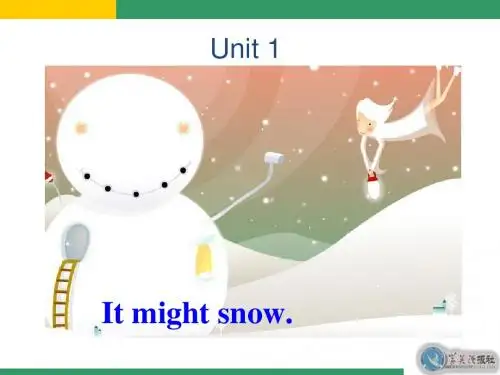
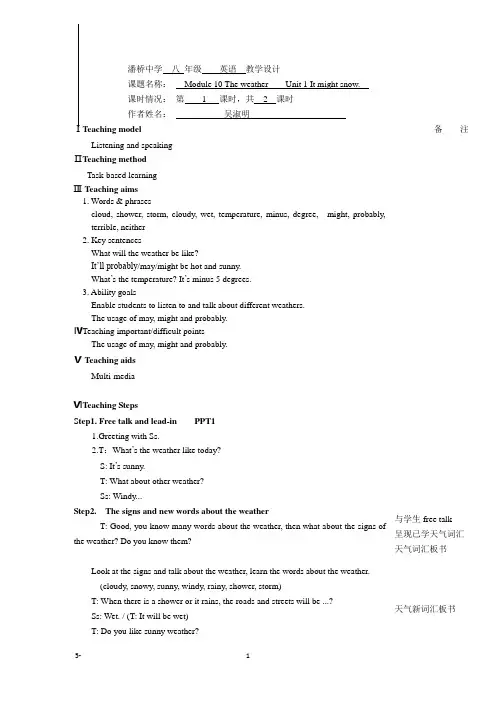
潘桥中学八年级英语教学设计课题名称:Module 10 The weather Unit 1 It might snow. 课时情况:第 1 课时,共 2 课时作者姓名:吴淑明ⅠTeaching modelListening and speakingⅡTeaching methodTask-based learningⅢ Teaching aims1. Words & phrasescloud, shower, storm, cloudy, wet, temperature, minus, degree, might, probably, terrible, neither2. Key sentencesWhat will the weather be like?It’ll probably/may/might be hot and sunny.What’s the temperature? It’s minus 5 degrees.3. Ability goalsEnable students to listen to and talk about different weathers.The usage of may, might and probably.ⅣTeaching important/difficult pointsThe usage of may, might and probably.Ⅴ Teaching aidsMulti-mediaⅥTeaching StepsS tep1. Free talk and lead-in PPT11.Greeting with Ss.2.T:What’s the weather like today?S: It’s sunny.T: What about other weather?Ss: Windy...Step2. The signs and new words about the weatherT: Good, you know many words about the weather, then what about the signs of the weather? Do you know them?Look at the signs and talk about the weather, learn the words about the weather.(cloudy, snowy, sunny, windy, rainy, shower, storm)T: When there is a shower or it rains, the roads and streets will be ...?Ss: Wet. / (T: It will be wet)T: Do you like sunny weather?备注与学生free talk呈现已学天气词汇天气词汇板书天气新词汇板书Ss: Yes.T: Me,too. Do you like stormy weather? Ss: No.T: Me neither. Why we don’t like it? Ss: Because it’s bad...T: We also can say it is terrible.(wet, terrible, me neither)Step3. May, might, probablyT: Today, the weather is fine. Then how about tomorrow? What will the weather be like tomorrow? Let’s guess.S: It will be ...T: Are you sure?S: It may be..T: Yes, we also can say”It might be...”Continue to guess.(2-3Ss)T: But the weather reporter says “It will probably be sunny.”...When do we use probably, what does it means?Ss: ...(T may translate it in Chinese.)Step4. ListeningT: We talked the weather in Wenzhou? What about other cities?Show the chart of listening.T: Let’s guess the weather in these cities.Ss: It might/may be ________in …(There might/may be ________in …)T: When we talk about the weather, we sometimes also talk about the temperature.How to read these temperatures?Ss:...T: Never mind, let’s learn in together. (teach Ss how to read)(temperature, degree, minus)Ask some Ss read the temperatures in the chart one by one.1. Listening. Check(√) the correct information.2.Listening. Correct the wrong temperature.3.Check the AnsAsk Ss use these sentences to check their Ans.It will probably be ...in…(There will probably be ...in…)In.., the temperature will be between...and...Step5. Pair workT: Now, we know what the weather will be like in these cities. Please choose one city 板书wet, terrible,Me neither.Me, too.板书What will the weather be like tomorrow?It will be ...It may/might be...It will probably be...在句型中使用操练might、may板书What’s the temperature?It’s minus 5 degrees.(里面包含新单词Temperature, degree, minus)听力(校对时用目标句型)and talk about it like this:A: What will the weather be like in…?B: It will probably be…(It will probably be…)A: What will the temperature be?B: It will be between…and..degree(s).A: Do you like the weather in…?B: Yes, I do./ No, I don’t. And you?A: Me, too./ Me, neither.Step6. Activity 4T: Betty, Tony, Lingling and Daming are talking about the weather in difference places.1. Listen to the conversation and write down the weather Betty, Tony, Lingling andDaming have mentioned.2. Listen and repeat: the sentences they talk about the weather..Step7. Group workT: Today, I listened to the weather about China, I learned the weather of today in these cities. But I didn’t finish listening, so I don’t what weather these cities will be. 在句型中使用操练probably编对话。
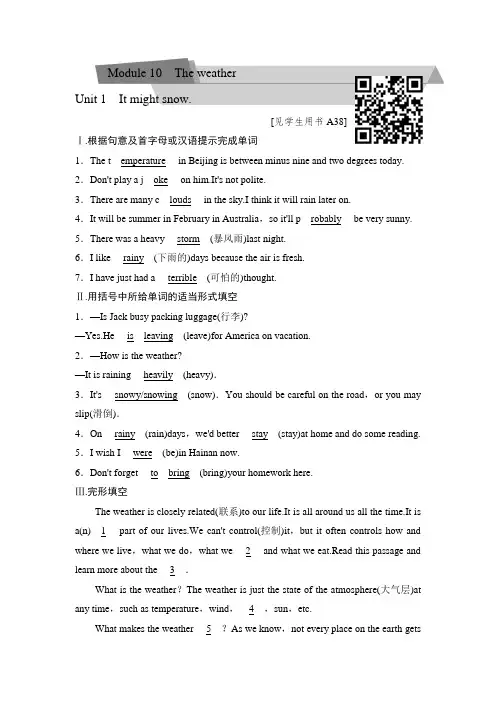
Module 10The weatherUnit 1It might snow.[见学生用书A38]Ⅰ.根据句意及首字母或汉语提示完成单词1.The t__emperature__ in Beijing is between minus nine and two degrees today. 2.Don't play a j__oke__ on him.It's not polite.3.There are many c__louds__ in the sky.I think it will rain later on.4.It will be summer in February in Australia,so it'll p__robably__ be very sunny. 5.There was a heavy __storm__(暴风雨)last night.6.I like __rainy__(下雨的)days because the air is fresh.7.I have just had a __terrible__(可怕的)thought.Ⅱ.用括号中所给单词的适当形式填空1.—Is Jack busy packing luggage(行李)?—Yes.He __is__leaving__(leave)for America on vacation.2.—How is the weather?—It is raining __heavily__(heavy).3.It's __snowy/snowing__(snow).You should be careful on the road,or you may slip(滑倒).4.On __rainy__(rain)days,we'd better __stay__(stay)at home and do some reading. 5.I wish I __were__(be)in Hainan now.6.Don't forget __to__bring__(bring)your homework here.Ⅲ.完形填空The weather is closely related(联系)to our life.It is all around us all the time.It is a(n)__1__ part of our lives.We can't control(控制)it,but it often controls how and where we live,what we do,what we __2__ and what we eat.Read this passage and learn more about the __3__.What is the weather?The weather is just the state of the atmosphere(大气层)at any time,such as temperature,wind,__4__,sun,etc.What makes the weather __5__?As we know,not every place on the earth getsthe same amount of __6__.Some places get more sunlight.So it's __7__ in those places.Some places get little or no sunlight in __8__.Then those places have lower temperatures in winter.These __9__ in temperature make the air and water move around the __10__.The movement helps to __11__ the heat energy from the sun across the earth.So the weather changes.What's the difference between weather and climate(气候)?Climate is a place's weather over a __12__ time.The weather changes from day to day and __13__ from hour to hour.It can be sunny in the morning,__14__ cold and wet in the afternoon.As for the climate,it changes very __15__ over lots of years.(A)1.A.important B.interestingC.helpful D.useful(A)2.A.wear B.hearC.like D.read(D)3.A.seasons B.lifeC.customs D.weather(B)4.A.water B.rainC.plants D.animals(B)5.A.return B.changeC.rise D.drop(C)6.A.rain B.snowC.sunlight D.moonlight(B)7.A.nicer B.warmerC.heavier D.richer(A)8.A.winter B.autumnC.summer D.spring(D)9.A.advantages B.changesC.movements D.differences(A)10.A.earth B.mountainsC.sun D.oceans(D)11.A.reach B.fetchC.blow D.take(C)12.A.good B.hardC.long D.short(D)13.A.also B.almostC.just D.even(D)14.A.so B.becauseC.as D.but(B)15.A.differently B.slowlyC.carefully D.easilyⅣ.阅读理解Maybe you know floods,earthquakes,sandstorms and so on.But have you heard of typhoons(台风)?Typhoons are some of the worst storms,usually around the Pacific Ocean and the South China Sea.Most of them happen in July,August and September.How does a typhoon happen?When lots of sea water gets hot in the summer sun,it evaporates(蒸发)into the air.This makes the air hotter.When the air gets warm enough,it starts to move higher up into the sky.After the air gets warmer,it starts to move quickly,making wind.The wind goes in circles and it keeps moving higher in the sky.The warmer the air gets,the quicker the wind moves.And when the wind moves faster than 32.7 metres a second,a typhoon begins.A typhoon has two parts.One is called the “eye”.In the eye,the wind does not move so fast.The other part is the wall of clouds around the eye.Here are the strongest winds and hardest rain.Typhoons are very dangerous.In November,2013,Typhoon Haiyan killed more than 5,500 people in Philippines(菲律宾).Many people went missing.What to do when a typhoon hits?☆Stay inside.Close all the windows and stay away from them.☆Try to bring all of your things inside.Strong winds can even blow away your bikes.☆Listen to the radio or watch TV for important information.(D)1.This passage is most probably from________.A.an advertisementB.a travel recordC.a weather reportD.a science magazine(A)2.Typhoons often happen________.A.in the hot seasonB.in the cold seasonC.only in ChinaD.under the sea(D)3.In which order does a typhoon happen?①The wind moves fast enough and then a typhoon starts.②The air moves quickly,making wind.③The sun makes sea water hot.④The air gets warmer.A.②③①④B.③①④②C.①③④②D.③④②①(C)4.Which of the following is TRUE according to the passage?A.The warmer the air gets,the slower the wind moves.B.About 7,100 people died because of Typhoon Haiyan in Philippines. C.The strongest winds and hardest rain are in the wall of clouds.D.A typhoon will not happen before the wind goes faster than 40 km a second. Ⅴ.词汇运用A.用方框中所给单词的适当形式填空。
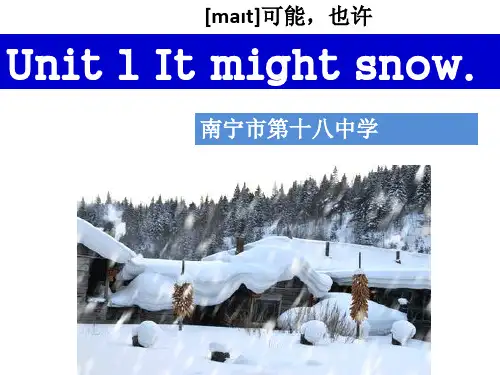
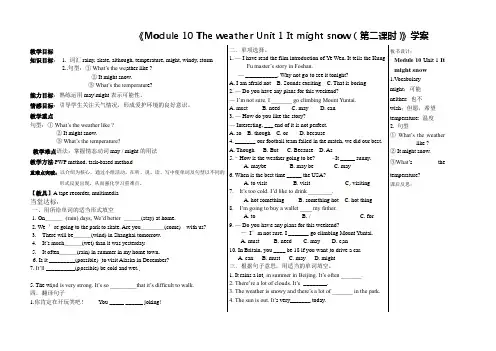
《Module 10 The weather Unit 1 It might snow(第二课时)》学案教学目标知识目标:1. 词汇rainy, skate, although, temperature, might, windy, storm2..句型:①What’s the we ather like ?② It might snow.③What’s the temperatur e?能力目标:熟练运用may\might表示可能性。
情感目标:引导学生关注天气情况,形成爱护环境的良好意识。
教学重点句型:①What’s the weather like ?② It might snow.③What’s the temperature?教学难点语法:掌握情态动词may / might的用法教学方法PWP method, task-based method重难点突破:以介绍为核心,通过小组活动,在听、说、读、写中使单词及句型以不同的形式反复出现,从而强化学习重难点。
【教具】A tape recorder, multimedia当堂达标:一、用所给单词的适当形式填空1. On___(rain) days, We’d better ___(stay) at home.2. We 're going to the park to skate. Are you____(come)with us?3.There will be___(wind) in Shanghai tomorrow.4.It’s much___(wet) than it was yesterday.5.It often___(rain) in summer in my home town.6. Is it _________(possible) to visit Alaska in December?7. It’ll __________(possible) be cold and wet.5. The wi nd is very strong. It’s so _________that it’s difficult to walk.四.翻译句子1.你肯定在开玩笑吧!You _____ ______ joking!2. 天气既不冷也不热。
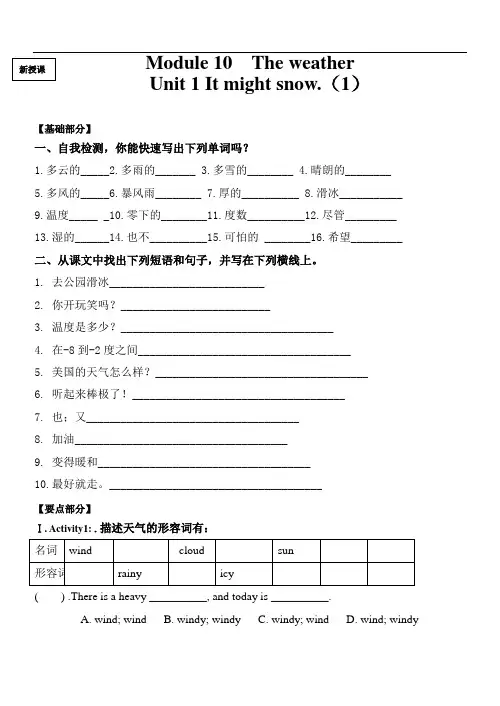
Module 10 The weather【基础部分】一、自我检测,你能快速写出下列单词吗?1.多云的_____2.多雨的_______3.多雪的________4.晴朗的________5.多风的_____6.暴风雨________7.厚的__________8.滑冰___________9.温度_____ _10.零下的________11.度数__________12.尽管_________13.湿的______14.也不__________15.可怕的 ________16.希望_________二、从课文中找出下列短语和句子,并写在下列横线上。
1. 去公园滑冰___________________________2. 你开玩笑吗?__________________________3. 温度是多少?_____________________________________4. 在-8到-2度之间_____________________________________5. 美国的天气怎么样?_____________________________________6. 听起来棒极了!_____________________________________7. 也;又_____________________________________8. 加油_____________________________________9. 变得暖和_____________________________________10.最好就走。
_____________________________________【要点部分】Ⅰ. Activity1: .描述天气的形容词有:( ) .There is a heavy __________, and today is __________.A. wind; windB. windy; windyC. windy; windD. wind; windyⅡ. Activity2: Listen and answer the questions.(预习不用做,课中做) 1.Who wants to skate?_________________________________________________2.Where are they going to skate?_________________________________________________3.What’s the temperature today?_________________________________________________Ⅲ. Activity3: Check the true sentences and correct the false.( F or T ) ( ) 1.Tony and Daming are going to skate.( ) 2.Winter is colder in Beijing than in England.( ) 3.It sometimes snows in England in winter.( ) 4.It is not hot in the US in summer.( ) 5. It usually snows in New York in winter.( ) 6.Tony does not like windy weather.Ⅳ. Activity4: Read and answer the questions.1.What’s the weather like today?_________________________________________________2.What’s the weather like in England?_________________________________________________3.What’s the weather like in America?_________________________________________________4.What’s the weather like in Australia?_________________________________________________Ⅴ. Activity4: Read again complete the passage.Activity5 on P81ⅤI. 跟读对话录音后,熟读对话。
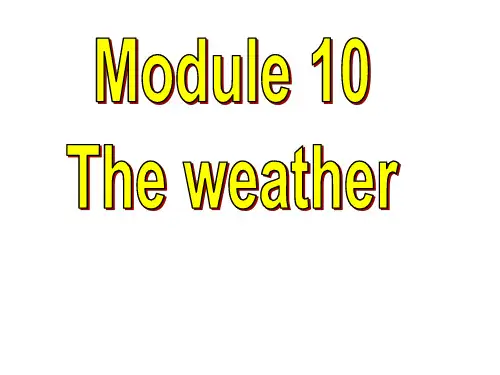

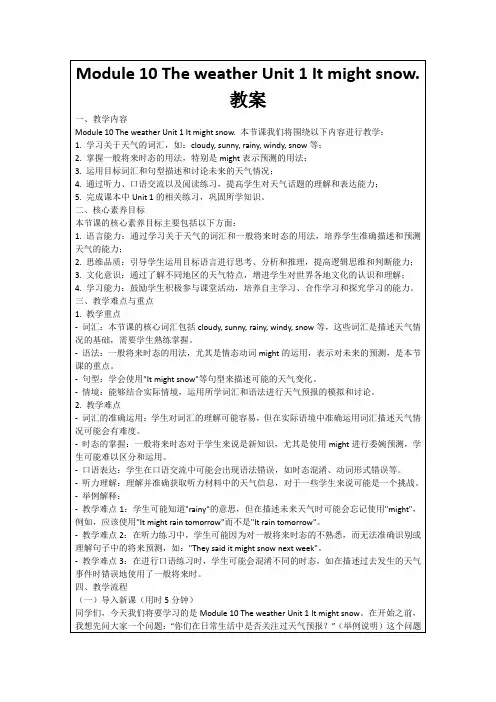
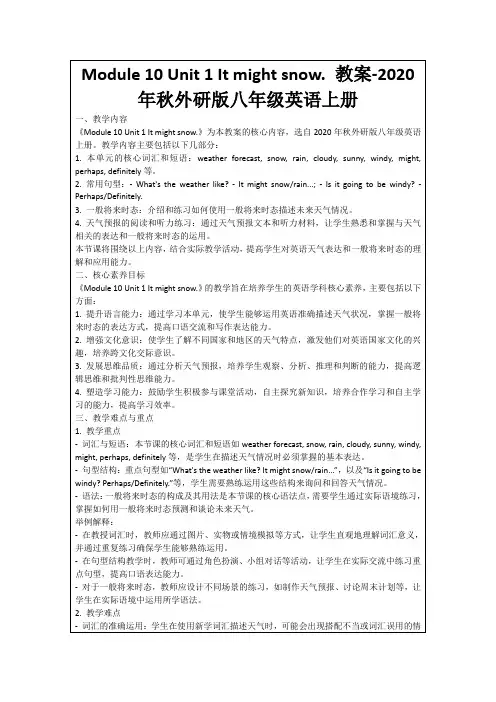
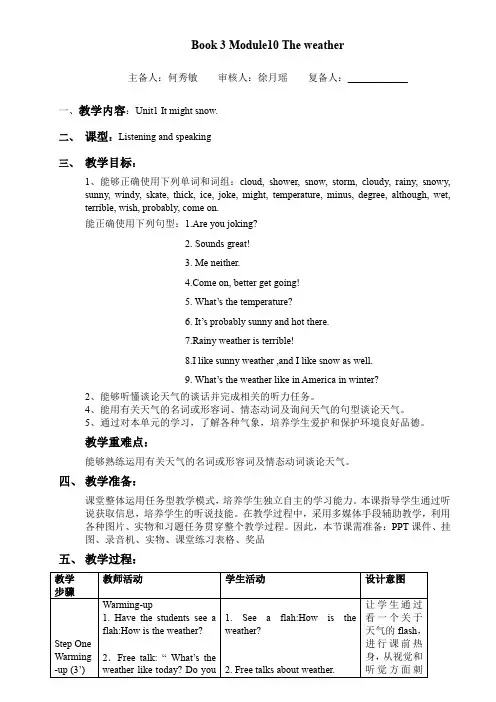
Book 3 Module10 The weather主备人:何秀敏审核人:徐月瑶复备人:____________一、教学内容:Unit1 It might snow.二、课型:Listening and speaking三、教学目标:1、能够正确使用下列单词和词组:cloud, shower, snow, storm, cloudy, rainy, snowy,sunny, windy, skate, thick, ice, joke, might, temperature, minus, degree, although, wet, terrible, wish, probably, come on.能正确使用下列句型:1.Are you joking?2. Sounds great!3. Me neither.e on, better get going!5. What’s the temperature?6. It’s probably sunny and hot there.7.Rainy weather is terrible!8.I like sunny weather ,and I like snow as well.9. What’s the weather like in America in winter?2、能够听懂谈论天气的谈话并完成相关的听力任务。
4、能用有关天气的名词或形容词、情态动词及询问天气的句型谈论天气。
5、通过对本单元的学习,了解各种气象,培养学生爱护和保护环境良好品德。
教学重难点:能够熟练运用有关天气的名词或形容词及情态动词谈论天气。
四、教学准备:课堂整体运用任务型教学模式,培养学生独立自主的学习能力。
本课指导学生通过听说获取信息,培养学生的听说技能。
在教学过程中,采用多媒体手段辅助教学,利用各种图片、实物和习题任务贯穿整个教学过程。
因此,本节课需准备:PPT课件、挂图、录音机、实物、课堂练习表格、奖品五、教学过程:教学步骤教师活动学生活动设计意图Step One Warming -up (3’)Warming-up1. Have the students see aflah:How is the weather?2.Free talk: “What’s theweather like today? Do you1. See a flah:How is theweather?2. Free talks about weather.让学生通过看一个关于天气的flash,进行课前热身,从视觉和听觉方面刺like cold weather? ”激学生思维,活跃了课堂气氛。
Module 10 Unit 1 教案2一、学习目标:A. 单词和短语:cloud, shower, snow, storm, cloudy, rainy, snowy, sunny, windy, skate, thick, ice, joke, might, temperature, minus, degree, although, wet, terrible, wish, probably, come on, mile, northwest, umbrella, southeast, from time to timeB. 交际用语:1. You’re joking!2. Sounds great!3. Come on!4. When is the best time to visit your country?5. What clothes should she bring?6. What’s the temperature?7. Where are you going?8. It’ll probably be cold tomorrow.9. It might be rainy.10. It’s probably sunny and hot there.11. Bring a map because you may want to travel around.二、教学目标1. Function: Describing the weather.2. Structure: may, might, probably (for possibility)3. Skills:1) Listening and understanding familiar topics (weather).2) Giving weather forecast based on clues; predicting about future weather using probably.3) Reading and finding specific information.4) Writing a short passage about the best time to visit your town, using because, so and but.4. Around the world: The wettest place5. Task: Preparing some advice on the best time to visit China三、重点及难点:1. Describing the weather.2. Grammar: The using of may, might, probably (for possibility)四、教学设计:Unit 1 It might snow.ⅠTeaching modelListening and speakingⅡTeaching methodInteractive approachⅢ Teaching aims1. To understand conversations about the weather;2. To get specific information from the listening material;3. To talk about possibilitiesⅣ Teaching Objectives1. Key vocabulary: cloud, shower, snow, storm, cloudy, rainy, snowy, sunny, windy, skate, thick,ice, joke, might, temperature, minus, degree, although, wet, terrible, wish,probably, come on2. Key structures: may, might, probably (for possibility)3. Key sentences:1) —What’s the temperature?—It’s between minus five and minus two degrees!2) —What’s the weather like in …? = How is the weather in …?—It’s snowy (cloudy, rainy, sunny, windy ...).3) … although this year it snowed a lot.4) Come on, better get going!5) It’s probably sunny and hot there.It’ll probably be cold tomorrow.Ⅴ Teaching aidsTape recorder, OHP, videoⅥTeaching StepsStep 1 Listen and repeat.1. Play the recording once without stopping.2. Play the recording again and ask the whole class to repeat.3. Listen to the speaker asking a question.What’s the weather like?4. Now listen to the speaker showing surprise.What’s the weather like?5 Listen and write *if the speaker is asking a question or **if he is showing surprise.1) When is the best time to visit your country?2) What clothes should she bring?3) What’s the temperature?4) Where are you going?6. Now listen again and repeat.Step 2 Language points1. 问气温:—What’s the temperature? 气温怎么?—It’s between minus five and minus two degrees! 零下5度到零下2度之间。
教学设计Module 10 The weather Unit 1 It might snow.、教材分析(一)教学内容分析“天气”话题是西方人人别是英国人日常生活经常谈论的话题。
本课由“天气”扩展到去一个地方旅游的最佳时间等内容,与学生的生活联系紧密,便于有效的提高学生的学习兴趣。
本单元由贝蒂和玲玲要去华庭引出了谈论天气的话题,借助这一常见的场景轻松地导入天伦天气的习惯表达和表示可能性的词汇和句型。
掌握好有关天气的表达方式,有助于学生更好地与他人交流,增进感情。
本单元的温度表达与Module 9 的数词关系密切,而Module 10, Module 11, Module 12 都涉及情态动词的用法。
(二)教学对象分析“天气”话题与日常生活紧密相关,八年级的学生都有真实的生活和经验基础,容易激起学习的主动性,而且小学阶段已接触过天气的表达。
同时,八年级学生的思维方式正在由感性认识到理性认识,形象思维到抽象思维转化,多媒体和信息技术的应用有助于提高课堂吸收率。
(三)教学环境分析本课选择在多媒体教室授课,符合学生心智发展的特点,有利于吸引学生注意力。
通过视觉和听觉的双重刺激,以及小组共同探讨、练习,生成知识,强化应用与实践,提高学习效率。
、教学目标(一)知识与能力:掌握天气,温度表达相关词汇,以及用may, might, probably 表达可能性的句型。
能理解天气相关对话,描述天气,表达可能性。
(二)过程与方法:问题引领,合作探究(三)情感态度与价值观:培养合作精神,激发了解世界各地天气的愿望和兴趣,开拓眼界。
三、教学重难点(一)教学重点:1.掌握有关天气表达的词汇,比如,sun-sunny, wind-windy, rain-rainy, snow-snowy, temperature, degree 等。
提问天气的句型:What 's the weather like? How is the weater?2.掌握正确的温度表达。